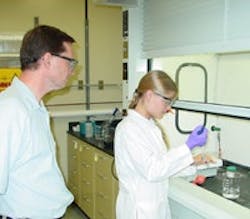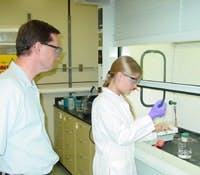Catalysts Provide Natural Advantages
Enzymes' ability to produce a single enantiomer can offer significant benefits for making pharmaceuticals, fragrances and other compounds. However, synthesis of such materials generally takes place in organic solvents — and enzymes generally don't perform well in non-aqueous systems. Now, however, a team at Kansas State University, Manhattan, Kan., has developed a way to prepare enzymes that enables them to efficiently catalyze reactions in organic solvents. Besides providing stereospecificity, use of the enzymes allows the products to be termed "natural" both for marketing and regulatory purposes.
Figure 1. Professor Peter Pfromm worked with visiting scientist Kerstin Wurges on the enzyme preparation development.
Source: Kansas State University.
Peter Pfromm, a professor of chemical engineering, in collaboration with visiting scientist Kerstin Wurges, who is now at Forschungszentrum Julich, Germany, prepared enzyme-coated nanoparticles of fumed silica (Figure 1). This structure avoids problems of clumping that otherwise would impede enzyme performance while exposing the greatest number of enzymes to the reaction mixture, thus maximizing end product output.
Basically, preparation involves adding a commercial-grade fumed silica (7–50-nm. particle diameter) to an aqueous buffer solution containing the enzyme before freeze-drying the solution. This provides a sharp boost in subsequent enzyme activity in organic solvents. For example, activity of Subtilisin Carlsberg in hexane increases 130-fold compared to the pure freeze-dried enzyme. The likely reason for this, explains Pfromm, is that the high-surface-area fumed silica overcomes mass-transfer limitations that otherwise would arise in using the enzyme in such solvents.
The amount of fumed silica needed in the buffer depends upon the surface area required to form an enzyme monolayer on the nanoparticles. A fumed silica content of 98.5 wt.% appears to offer the optimum performance with Subtilisin Carlsberg.
"Enzymes are exceedingly good at taking reactants and making them into only one of the versions [the active enantiomer], not both," notes Pfromm. "Biocatalysts are exquisitely selective compared to chemical catalysts. Biocatalysts may be less productive but their selectivity is often unmatched by artificial catalysts." Moreover, fumed silica is cheap and already used in foods. So, minute quantities in pharmaceuticals or other end products shouldn't raise any safety concerns, unlike the residues of some chemical catalysts.
"One can perhaps expect a ten-fold increase in market value if a chemical such as geranyl acetate is made via enzymatic catalysis in solvents versus chemical catalysis. This is due to the regulations that allow labeling as 'natural' if enzymes are used. This translates to similar value increases whenever food, fragrances, etc., are the product," says Pfromm. "The value increase for pharmaceuticals if produced enzymatically as enantiopure compounds versus chemically as a mixture of stereoisomers can reach from marketing to the recent regulatory tendency to require enantiopure compounds."
The technology reportedly is now poised for use. "There are really no serious challenges remaining," Pfromm contends. "Commercialization could be very quick since the production of the preparation is easy and scalable, and we have shown both packed-bed reactors and stirred-tank reactors."
A patent on the enzyme preparations recently has been issued. The Kansas State University Research Foundation is now seeking licensees "We are looking for interested parties and have had discussions with companies both in the enzyme manufacture and fine chemicals areas," Pfromm notes.

